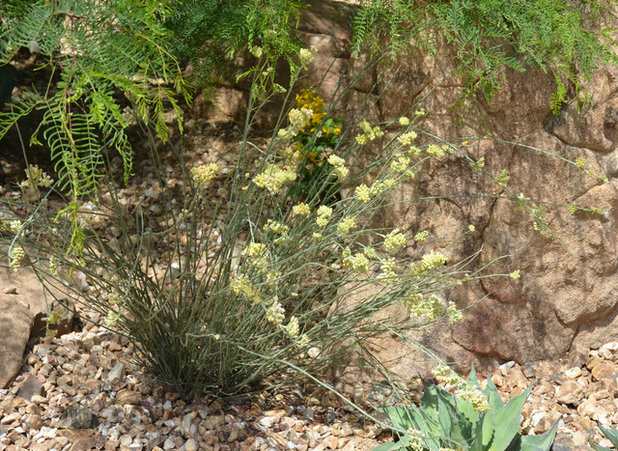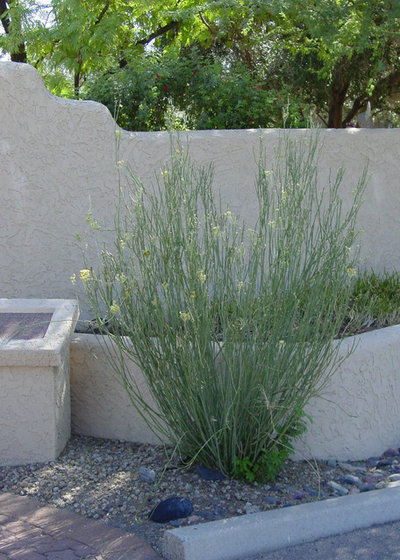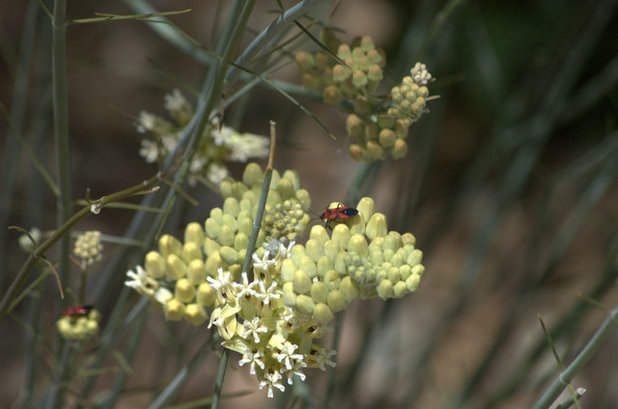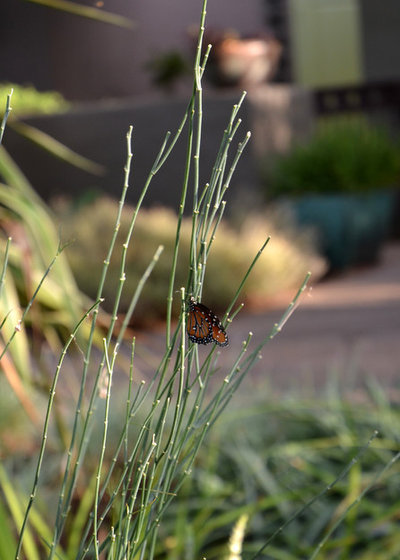Milkweed is known to be an important part in the life cycle of monarch butterflies, and the Southwest has its own native species. Rush milkweed (
Asclepias subulata), also called desert milkweed, has upright succulent stems topped with creamy yellow flowers that are an important food source to both monarch and queen butterfly species in fall. This desert native thrives in areas with full, reflected sun and little water and is the only evergreen milkweed native to the U.S.

Noelle Johnson Landscape Consulting
Botanical name: Asclepias subulataCommon names: Rush milkweed, desert milkweed
Origin: Native to the desert Southwest, including Arizona, California, Nevada and northern Mexico
Where it will grow: Hardy to 20 to 25 degrees Fahrenheit, or minus 7 to minus 4 degrees Celsius (USDA zone 9; find your zone)
Water requirement: Low
Light requirement: Full sun
Mature size: 3 to 4 feet tall and wide
Benefits and tolerances: Extremely drought-tolerant once established; water once a month May through September
Seasonal interest: Flowers spring through fall; attracts butterflies (including monarchs), hawk moths and bees
When to plant: Fall, winter and spring

Noelle Johnson Landscape Consulting
Shown: A queen butterfly (
Danaus gilippus)
visits a rush milkweed plant at the Desert Botanical Garden in Phoenix.

Noelle Johnson Landscape Consulting
Distinguishing traits. This native milkweed species provides attractive gray-green color to the landscape throughout the year. Rush milkweed’s succulent stems are usually leafless except for 2-inch-long narrow leaves that briefly appear on new growth during the warm season. When grown in full sun, the stems have an attractive upright growth habit that adds a vertical element to the landscape.

Noelle Johnson Landscape Consulting
The creamy yellow buds open to reveal tiny five-petaled flowers in spring and periodically in summer and fall. The flowers serve as a larval food source for the caterpillars of monarch and queen butterfly species. Bees and other insects such as the black and red milkweed bug are also attracted to the flowers.
Horn-shaped seedpods follow the flowers. They are filled with black seeds attached to a silvery hair, which allows them to float away once the pods split open.

Noelle Johnson Landscape Consulting

Noelle Johnson Landscape Consulting
How to use it. Rush milkweed’s attractive upright growth habit makes it extremely versatile in the landscape, whether scattered throughout a natural desert design or planted in straight rows for a more formal, contemporary style. Plant it alongside flowering drought-tolerant desert natives such as blackfoot daisy (
Melampodium leucanthum), brittlebush (
Encelia farinosa) and firecracker penstemon (
Penstemon eatonii). Its ability to thrive in hot, reflected areas makes it a great choice in raised planters, against a west-facing wall or along a walkway.
Shown: Rush milkweed planted in a narrow planter, where it thrives in the hot, reflected sun.

Noelle Johnson Landscape Consulting
Pair rush milkweed with other succulents such as Santa Rita prickly pear (
Opuntia violacea santa-rita) and artichoke agave (
Agave parryi var
. truncata) to create an interesting study of contrasting shapes and textures.
Shown: Rush milkweed growing in a raised planter alongside an artichoke agave and a blackfoot daisy.

Noelle Johnson Landscape Consulting
Planting notes. Plant in well-drained soil in an area that receives full or even reflected sun. No fertilizer or soil amendments are needed.
Maintenance is very low. Prune any leggy or damaged stems back to the base in late winter. Be sure to wear gloves when pruning since the interior of the stems contains a milky sap that is irritating to the skin and toxic if ingested. Interestingly, the sap contains rubber, but rush milkweed isn’t a common source of rubber.
Shown: A queen butterfly on rush milkweed in fall.





